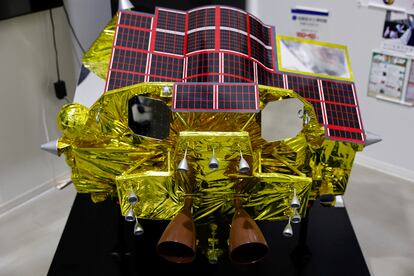Japan space agency says its lunar spacecraft is on the moon but is still ‘checking its status’
While most previous probes have used landing zones some 6 miles wide, SLIM was aiming at a target of just 330 feet

Japan’s space agency said early Saturday that its spacecraft is on the moon, but is still “checking its status.” More details will be given at a news conference, officials said.
The Smart Lander for Investigating Moon, or SLIM, came down onto the lunar surface at around 12:20 a.m. Tokyo time Saturday (1520 GMT Friday). No astronauts were onboard the spacecraft.
As the spacecraft descended, the Japan Aerospace Exploration Agency’s mission control said that everything was going as planned and later said that SLIM was on the lunar surface. But there was no mention of whether the landing was successful.
Mission control kept repeating that it was “checking its status” and that more information would be given at a news conference. It wasn’t immediately clear when the news conference would start.
SLIM, nicknamed “the Moon Sniper,” started its descent at midnight Saturday, and within 15 minutes it was down to about 10 kilometers (six miles) above the lunar surface, according to the space agency, which is known as JAXA.
At an altitude of five kilometers (three miles), the lander was in a vertical descent mode, then at 50 meters (165 feet) above the surface, SLIM was supposed to make a parallel movement to find a safe landing spot, JAXA said.
About a half-hour after its presumed landing, JAXA said that it was still checking the status of the lander.
The Smart Lander for Investigating Moon, a lightweight spacecraft about the size of a passenger vehicle, is using “pinpoint landing” technology that promises far greater control than any previous moon landing.
While most previous probes have used landing zones some 10 kilometers (6 miles) wide, SLIM is aiming at a target of just 100 meters (330 feet).
It’s the fruit of two decades of work on precision technology by the Japan Aerospace Exploration Agency, or JAXA. If successful, it would make Japan the fifth country to land on the moon, after the United States, Russia, China and India.
The mission’s main goal is to test new landing technology that would allow moon missions to land “where we want to, rather than where it is easy to land,” JAXA has said. After landing, the spacecraft will seek clues about the origin of the Moon, including analyzing minerals with a special camera.
The SLIM, equipped with a pad to cushion impact, aims to land near the Shioli crater, near a region covered in volcanic rock.
The closely watched mission comes only 10 days after a moon mission by a U.S. private company failed when the spacecraft developed a fuel leak hours after the launch.
SLIM lowered its orbit to 15 kilometers (9.3 miles) above the lunar surface on Friday, from which it will make a final approach to a touchdown, JAXA said. The attempt is scheduled 20 minutes after midnight Tokyo time on Saturday.
Nicknamed the Moon Sniper, it was launched on a Mitsubishi H2A rocket in September. It initially orbited Earth and entered lunar orbit on Christmas Day.
Japan also hopes a success will help regain confidence for its space technology after a number of failures. A spacecraft designed by a Japanese company apparently crashed during a lunar landing attempt in April, and a new flagship rocket failed its debut launch in March.
JAXA has a track record with difficult landings. Its unmanned Hayabusa2 spacecraft, launched in 2014, touched down twice on the 900-meter (3,000-foot) -long asteroid Ryugu, collecting samples that were returned to Earth.
Experts say a success of SLIM’s pinpoint landing, especially on the Moon, would raise Japan’s profile in the global space technology race.
Takeshi Tsuchiya, aeronautics professor at the Graduate School of Engineering at the University of Tokyo, said it is important to confirm the accuracy of landing on a targeted area for the future of moon explorations.
“It is necessary to show the world that Japan has the appropriate technology in order to be able to properly assert Japan’s position in lunar development,” he said. The Moon is important from the perspectives of explorations of resources, and it can also be used as a base to go to other planets, like Mars, he said.
SLIM is carrying two small autonomous probes, “lunar excursion vehicles” LEV-1 and LEV-2, which will be released just before landing.
LEV-1, equipped with an antenna and a camera, is tasked with recording SLIM’s landing. LEV-2, is a ball-shaped rover equipped with two cameras, developed by JAXA together with Sony, toymaker Tomy and Doshisha University.
JAXA will broadcast a livestream of the landing, while space fans will gather to watch the historic moment on a big screen at the agency’s Sagamihara campus southwest of Tokyo.
Sign up for our weekly newsletter to get more English-language news coverage from EL PAÍS USA Edition
Tu suscripción se está usando en otro dispositivo
¿Quieres añadir otro usuario a tu suscripción?
Si continúas leyendo en este dispositivo, no se podrá leer en el otro.
FlechaTu suscripción se está usando en otro dispositivo y solo puedes acceder a EL PAÍS desde un dispositivo a la vez.
Si quieres compartir tu cuenta, cambia tu suscripción a la modalidad Premium, así podrás añadir otro usuario. Cada uno accederá con su propia cuenta de email, lo que os permitirá personalizar vuestra experiencia en EL PAÍS.
¿Tienes una suscripción de empresa? Accede aquí para contratar más cuentas.
En el caso de no saber quién está usando tu cuenta, te recomendamos cambiar tu contraseña aquí.
Si decides continuar compartiendo tu cuenta, este mensaje se mostrará en tu dispositivo y en el de la otra persona que está usando tu cuenta de forma indefinida, afectando a tu experiencia de lectura. Puedes consultar aquí los términos y condiciones de la suscripción digital.










































